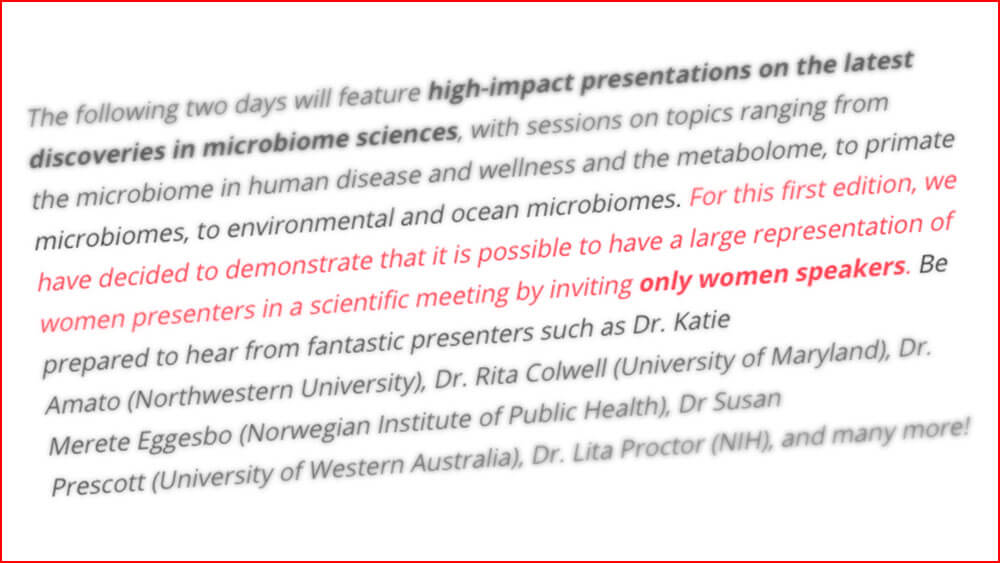In the late 1960s, when Philip Morris marketed Virginia Slims — the very first cigarette brand for women — the tobacco company came up with the slogan, “You’ve come a long way, baby.” As Convene has frequently reported, when it comes to being equally represented on the conference stage, women still have a long way to go. Today, on International Women’s Day, we look at one conference that recently came under fire for going too far in trying to make up the difference — by featuring only women scientists as speakers.
A three-day microbiome conference, held at the University of California, San Diego (UCSD), Feb. 26–28, attracted about 250 specialists from industry and academia — of which 54 percent of them were women. Two of the three days, when the 1st annual CMI International Microbiome Meeting (CIMM) took place, featured only women speakers. The conference’s primary host, UCSD’s Center for Microbiome Innovation (CMI), decided “to demonstrate that it is possible to have a large representation of women presenters in a scientific meeting by inviting only women speakers.”
That statement (partly shown above), originally posted on the university’s website, was later taken down amid controversy stemming from a Wall Street Journal opinion piece (paywall), according to an article in The Scientist. Written by Journal assistant editorial page editor James Freeman, the opinion column claimed that the “ban on male presenters” violated UCSD’s student code of conduct, and was discriminatory.
In an interview with life sciences media site Stat, the conference’s co-organizer, Sandrine Miller-Montgomery, tried to set the record straight. “We just wanted to show it is possible to have 100-percent women speakers,” she said. The point, she added, was to disprove the argument she often hears in defense of all-male panels or mostly male conferences — that it’s too hard to find women speakers. CMI lined up 27 women scientist speakers at Microbiome.
And while no male speakers were added at the last minute to mend fences, at the end of the conference, a panel of experts was scheduled to discuss how to fix gender imbalance in technical fields and decide whether invitations to speak at next year’s event be sent once again to women only. That panel, the Stat article said, would be made up of two men and two women.
Which would sit well with Joanne Lipman, author of the recent book, That’s What She Said: What Men Need to Know (And Women Need to Tell Them) About Working Together. The premise of her book, as you might gather from the title, is that the larger conversation of fair representation of women (beyond the conference stage to the workforce) needs to include men. Lipman points out that a recent Harvard study found that corporate “diversity training” has actually widened the gender gap, in part, because it makes men feel demonized.
That was intentional, according to a veteran diversity trainer interviewed by Lipman in the book. “We used to do it with a two-by-four,” Howard Ross told Lipman. “We beat ’em up until they saw the error of their ways. If somebody cried, that was great.”
Women, on the other hand, Lipman writes, “have pretty much wiped our hands clean of men, cutting them out of the conversation altogether. An entire industry of books, conferences, and networking groups has blossomed to tell us that closing the gender gap is up to us, not them. We’re told we need to speak up, to be more confident, to demand to be paid what we’re worth. We talk endlessly among ourselves about all of this. What we don’t do is talk to men about it.
“That disconnect between men and women makes no sense,” Lipman writes. “We need men to join the conversation, to be our partners.”
More From Convene on Gender Parity
- Bizzabo Finds ‘Pretty Big Discrepancy’ in Speaker Diversity
- Manels, the Gender Avenger is Coming After You
- All-Male Speaker Line-Up Derails History Conference
- Is the All-Male Panel on the Endangered Species List?
- How to Add More Women Speakers to Your Meetings
- How Can We Create Workplaces and Events Where Diversity Thrives?
- How — and Why — You Should Break out of Your Bubble
Michelle Russell in Convene editor-in-chief. [email protected]

